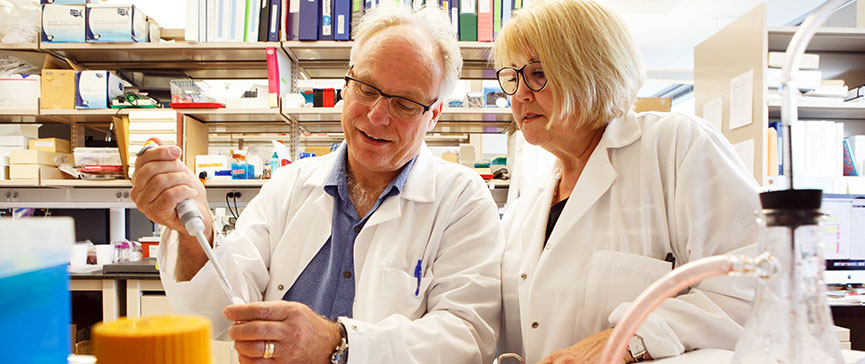Building Better Babies for Improved Lifelong health
Understanding developmental origins of health and disease

By Mark Couch
(December 2017) More than 60 investigators from the CU School of Medicine have joined together to study ways to improve lifelong health by addressing the health conditions in pregnancy that impact the developing fetus in the womb.
Called “Building Better Babies,” the program was created when Thomas Jansson, MD,
Though their initiative wasn’t selected for the Dean’s Transformational Research Funding program, the faculty decided to continue working together, establishing a network of investigators based at CU working in an emerging field of study.
“When I was in medical school many, many years ago, back in Sweden, we were taught that disease originates from an interaction of two main factors: genes and lifestyle,” Jansson said. “And that was a paradigm we lived with for a long time.
“In the last 10 to 20 years, this paradigm has been revised. We are beginning to understand that in addition to genes and lifestyle,
This concept – called
“We believe it has incredibly important public health consequences and will change the way we practice medicine,” said Jansson, who is chief of the Division of Reproductive Sciences and vice chair of research in the Department of Obstetrics and Gynecology.
“Diabetes, obesity and other metabolic diseases are critical areas impacted by intrauterine factors and it may be possible to prevent or at least curb the current epidemic of these diseases by intervening in early life,” Jansson said. “Mental health disorders, such as autism and schizophrenia, also have intrauterine origins and the fact is that we have researchers on this campus who are intervening in pregnancy to prevent those diseases in children.
“The
Expanding the map
The Building Better Babies program is based on this general idea and seeks to leverage a strength on the Anschutz Medical Campus. Jansson and Powell knew there were many individual investigators across different departments in the School of Medicine – and in other schools on the campus – with their own National Institutes of Health funding in this area. Why not bring them together?
Thomas Jansson, MD,
“We strongly argue that we need to be a center or a program, to do cutting-edge research, and to inform our colleagues because many in adult medicine, have no idea about his concept,” said Powell, professor in the Section of Neonatology, Department of Pediatrics. “Some say, ‘This doesn’t really affect me.’ And we say, ‘Yes it does.’”
As a result, education of colleagues on campus became a critical mission for the team leading Building Better Babies. Last spring, they hosted a daylong conference that assembled researchers on campus, hosted experts in the field, and included poster presentations from early career investigators.
Richard Johnston, Jr., MD, professor emeritus of pediatrics who was the medical director of the March of Dimes when it began its folic acid awareness campaign in the 1990s, told the organizers that the symposium was “a major event” for the campus with the potential for significant impact on perinatal health.
For Powell and Jansson, the effort is not simply a theoretical premise or administrative exercise. They also conduct perinatal research that could lead to lifelong health improvements for the next generation.
“One of the focus areas of our research is maternal obesity,” Jansson said. “If you include being overweight as associated with risk, there’s actually two-thirds of all pregnant women starting pregnancy either obese or overweight.”
“It’s the most common complication in pregnancy,” Powell said. “Nothing else – diabetes, preeclampsia, pre-term birth – come anywhere close to 60 percent of the pregnant population.”
In particular, Powell and Jansson are interested in how to address the baby’s risk of metabolic disease later in life when the mother is obese or develops gestational diabetes.
In their studies, they are examining the effect of supplementing the obese mother with adiponectin. Adiponectin is secreted from fat tissue and modulates multiple metabolic processes. Typically, a lean person has high levels and an obese person has low levels of this hormone.
“It has been called the good hormone that everybody wants to have because it increases your insulin sensitivity and that is a good thing,” said Jansson.
“In our mouse model of maternal obesity, we see all of these problems in pregnancy: we get bigger babies, they have too high glucose, and when they’re three to five months of age, they develop metabolic disease and cardiovascular disease, as have also been found in epidemiological studies in humans,” Jansson said.
“Our basic studies have suggested that adiponectin in the mother is incredibly important, the fact that it’s low in obese pregnancies impacts both the mother and her developing baby,” he said. “In our mouse studies we have supplemented the mother to increase this hormone to levels found in normal mice and basically we have completely prevented the adverse effects on placental function, fetal growth and long-term health of the offspring.”
As Powell and Jansson aim to translate their basic science results into clinical use, they are also hoping that the Building Better Babies program promotes working relationships between faculty members who might not otherwise make connections.
“In the delivery room when the baby is born, the obstetrician hands that baby off to the pediatrician,” Powell said. “The two doctors turn to their respective patients: the pediatrician goes off with the baby and the obstetrician takes care of the mother.
“And one of the things that Thomas and I are trying to do, and one advantage of having his appointment in obstetrics and mine in neonatology, is we’re trying to get them talking to each other. In particular, there are many kinds of interactions to share. We want to encourage the pediatrician to be looking back into the pregnancy data in [electronic health records] and the obstetrician to be having a better understanding the importance of what is happening long-term with that baby.”